Click on images to enlarge

infestation during spring (Photo: Sheldon Navie)
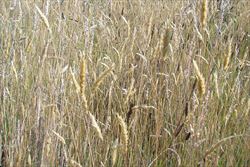
infestation during autumn (Photo: Forest and Kim Starr, USGS)
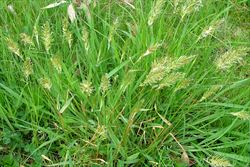
habit (Photo: Sheldon Navie)

habit (Photo: Sheldon Navie)
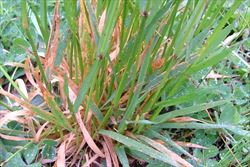
tufted leaves at the base of the plant (Photo: Sheldon Navie)
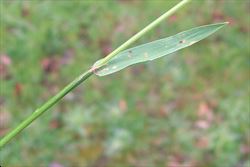
close-up of stem and leaf (Photo: Sheldon Navie)
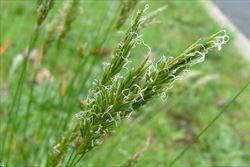
seed-heads (Photo: Sheldon Navie)
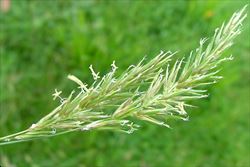
close-up of flower spikelets (Photo: Sheldon Navie)

close-up of mature flower spikelets with small bent awns (Photo: Sheldon Navie)
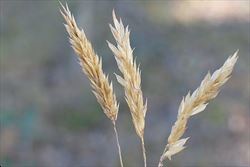
old seed-heads (Photo: Jackie Miles and Max Campbell)

habit during late summer (Photo: Forest and Kim Starr, USGS)
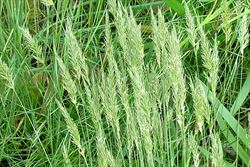
seed-heads (Photo: Sheldon Navie)
Scientific Name
Anthoxanthum odoratum L.
Family
Gramineae (South Australia)Poaceae (Queensland, New South Wales, the ACT, Victoria, Tasmania, Western Australia and the Northern Territory)
Common Names
scented vernal grass, scented vernal-grass, spring grass, sweet vernal, sweet vernal grass, sweet vernal-grass, sweet vernalgrass, sweet-scented vernal grass
Origin
Native to north-western Africa (i.e. Algeria, Morocco and Tunisia), the Azores, the Madeira Islands, the Canary Islands, Europe and northern Asia (i.e. north-western Iran, Turkey, Armenia, Azerbaijan, Georgia, Kazakhstan, Kyrgyzstan, Russia, Mongolia, China, Korea and Japan).
Cultivation
This species has been cultivated in pastures and as a garden plant, and is occasionally still sold by some nurseries.
Naturalised Distribution
Widely naturalised in southern and eastern Australia. This species is common in eastern New South Wales, the ACT, Victoria, Tasmania, south-eastern South Australia and south-western Western Australia. It is also occasionally naturalised in south-eastern Queensland and along the southern coast of Western Australia, is naturalised on Norfolk Island, and was once recorded on Macquarie Island.
Widely naturalised in other parts of the world including Africa, New Zealand, the USA, Central America, South America, La Réunion and Hawaii.
Habitat
Commonly a weed of pastures, roadsides, disturbed sites and waste areas in the temperate regions of Australia. It also invades coastal environs, heathlands, heathy woodlands, grasslands, open woodlands, moist forests, temperate rainforest margins, riparian vegetation, freshwater wetlands, and alpine and sub-alpine vegetation.
Habit
A tufted, long-lived (i.e. perennial), grass usually growing 10-80 cm tall, but occasionally reaching up to 1 m in height.
Distinguishing Features
- a tufted, long-lived grass usually growing 10-80 cm tall.
- its elongated leaves may be hairless or somewhat hairy and where the leaf sheath meets the leaf blade there is a small membranous structure 1-5 mm long.
- its narrow and spike-like seed-heads (1-12 cm long) are borne at the tips of its upright stems.
- these seed-heads consist of numerous hairy flower spikelets (6-10 mm long).
- its flower spikelets turn from green to light brown or straw-coloured as they mature.
- this species also gives off a strong scent of freshly-mown grass.
Stems and Leaves
The upright (i.e. erect) flowering stems (i.e. culms) are slender, hairless (i.e. glabrous) and unbranched.
The leaves consist of a leaf sheath, which partially encloses the stem, and a spreading leaf blade. The leaf blades (1-31cm long and 1.5-9 mm wide) are rolled when developing, but flatten out as they mature. They are entire with long-pointed tips (i.e. acuminate apices) and are hairless (i.e. glabrous) or have some scattered hairs (i.e. sparsely pubescent) on both surfaces. Where the leaf sheath meets the leaf blade there is a small membranous structure (i.e. ligule) 1-5 mm long.
Flowers and Fruit
The seed-head is a narrow spike-like cluster (i.e. spiciform panicle) and is borne at the tips of the stems. These seed-heads (1-12 cm long and 0.7-2 cm wide) consist of numerous flower spikelets (6-10 mm long) that are borne on very short stalks (i.e. pedicels) 0.5-1 mm long. Each flower spikelet has a pair of bracts (i.e. glumes) at the base, one of which is about twice as large as the other. They are somewhat hairy and have a single tiny flower (i.e. floret) topped with a small bent awn (6-9 mm long). These tiny flowers have two floral bracts (i.e. a lemma and palea) and both male and female flower parts (i.e. three stamens and an ovary topped with a style and two-branched stigma). Flowering occurs mostly during spring and summer (i.e. from November to January).
The flower spikelets turn from green to light brown or straw-coloured as they mature and break apart above from the seed-heads above their bracts (i.e. glumes). The 'seed' (i.e. caryopsis or grain) remains contained within the other floral parts.
Reproduction and Dispersal
Sweet vernal grass (Anthoxanthum odoratum) reproduces mainly by seed.
These seeds are commonly dispersed by wind, water, animals and vehicles. They may also be spread in contaminated agricultural produce, particularly fodder, and in dumped garden waste.
Environmental Impact
Sweet vernal grass (Anothoxanthum odoratum) is regarded as a significant environmental weed in Victoria and as an environmental weed in Western Australia, Tasmania and New South Wales. This species tolerates a wide range of conditions and is a widespread weed found in many natural settings, but it is most invasive in moist or low fertility soils in sunny or semi-shaded sites. It is often a weed of remnant native grassy vegetation, where it can form dense swards that suppress and replace native groundcover species.
Sweet vernal grass (Anothoxanthum odoratum) is currently of most concern in Victoria, and is regarded as a very serious threat to one or more vegetation formations in this state. It appears on numerous local and regional environmental weed lists in Victoria (e.g. in Monash City, Knox City, Banyule City, Colac-Otway Shire, Mornington Peninsula Shire, the Goulburn Broken Catchment and the Kananook Creek area) and has been recorded in many conservation areas in this state. There are extensive naturalised populations in Ferntree Gully National Park and Tarra Bulga National Park, and it is also present in Morwell National Park, Phillip Island Nature Park, Pomborneit North Nature Conservation Reserve and Boonderoo Nature Conservation Reserve.
This invasive grass is also seen as a threat to the survival of some rare and threatened native ground-cover species in Victoria. For example, it invades the preferred habitat of wrinkled buttons (Leiocarpa gatesii), a small annual species that is restricted to fairly open vegetation and areas along roadsides in the Lorne/Anglesea area. Invasion from sweet vernal grass (Anthoxanthum odoratum) and other weed species is also seen as the most serious threat facing the Gorae leek orchid (Prasophyllum diversiflorum), an endangered species that is known from only six isolated populations in south-western Victoria.
In New South Wales, sweet vernal grass (Anthoxanthum odoratum) is of most concern in the Southern Tablelands region, but is also listed as a problem species in the South Coast region and the wider Sydney and Blue Mountains region. It has been recorded in several conservation areas in the New South Wales southern tablelands (e.g. Burnt School Nature Reserve, Strike-a-Light Nature Reserve and disturbed areas within Kosciuszko National Park) and there is also concern about outbreaks of this species in the Namadgi National Park and Tidbinbilla Nature Reserve in the ACT.
Introduced grasses, including sweet vernal grass (Anothoxanthum odoratum), are abundant at two of the three known sites where natural populations of the Tarengo leek orchid (Prasophyllum petilum) still exist. This native ground orchid is restricted to grassy habitats in the Canberra-Boorowa region, and is listed as endangered in New South Wales and the ACT. These introduced grasses appear to invade these sites without disturbance, has become more prominent in recent times, and are thought to be the most serious threat to the survival of the Tarengo leek orchid (Prasophyllum petilum) at one of these sites.
In south-western Western Australia, sweet vernal grass (Anothoxanthum odoratum) is a common weed of disturbed wetlands, road verges and pastures. It was recently ranked as a moderate priority species in the Environmental Weed Strategy of Western Australia, and is primarily of concern along waterways and in wetlands in this state. It is also seen as a problem species or potential problem species in wetlands, grasslands and coastal sites in Tasmania.
Though sweet vernal grass (Anothoxanthum odoratum) does not tend to appear on environmental weed lists in South Australia, it was recently found to be one of the five most commonly recorded weed species in wetlands on the Fleurieu Peninsula. It is also present in several conservation areas in this state (e.g. Totness Recreation Park, Cleland Conservation Park, Kyeema Conservation Park and Mount George Conservation Park).
Legislation
This species is not declared or considered noxious by any state or territory government in Australia.
Management
For information on the management of this species see the following resources:
- the Sweet vernal grass page on the South Coast Weeds website at http://www.esc.nsw.gov.au/Weeds/index.asp.
Similar Species
Sweet vernal grass (Anothoxanthum odoratum) is very similar to the relatively rare introduced species Anthoxanthum aristatum, which is only naturalised in some parts of Victoria. However, Anthoxanthum aristatum is a short-lived (i.e. annual) species that does not form large tufts and has relatively loose seed-heads.
Sweet vernal grass (Anothoxanthum odoratum) is also similar to some native plumegrasses (Dichelachne spp.) and bent-grasses (Deyeuxia spp.). However, the plumegrasses (Dichelachne spp.) and bent-grasses (Deyeuxia spp.) can usually be distinguished by the fact that both of the bracts (i.e. glumes) at the base of their flower spikelets are about the same size.

